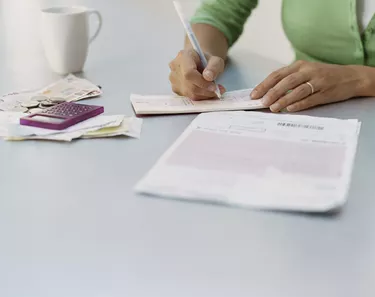If you're going to be in the United Kingdom for more than a few months, it makes sense to open a British bank account. Most towns have physical branches of the nation's biggest banks including Barclays, HSBC, Lloyds and National Westminster, and all but the very smallest institutions offer telephone and online banking. Writing a British cheque is very similar to writing a U.S. check. The required information is exactly the same, and there are lots of prompts on the face of the cheque to tell you where to write it.

Video of the Day
Write the Date
The date line appears in the top right-hand corner of the cheque. In this field, you generally will write the day you are writing the cheque although you can post date a cheque by writing a future date. This would prevent the payee from depositing the cheque until the date you've written. Remember to use British date format, which is day, month, year. For example, you would write "10 April 2018" or "10/04/18." The U.S. format of mm/dd/yy is never used in the U.K., and writing it would lead to massive confusion.
Video of the Day
Write the Name of the Payee
The next line of the cheque below the date line starts with the printed word "Pay." On this line, write the payee's name with enough detail to identify him. For example, you could write "Jonathan Peters" or "Mr. J. Peters." You can write more than one name but the recipients can only deposit the cheque if they have a joint bank account. Take care with business names. Ideally, the name you write should match what's on the payee's business bank account. You'll find this information on their invoice or letterhead.
Write the Amount in Words
On the line below the payee line, write in words the amount the cheque is for. British convention is slightly different to what you may be used to in the United States, since the amount should always end with the word "only." For a round number of pounds, for example, £50, write "Fifty pounds only." For pounds and pence, for example, £36.25, write "Thirty-six pounds and twenty-five pence only" or "Thirty-six pounds and 25 pence only." You must write the pound amount in words but you can use figures for the pence amount. Do not write the pence amount as a fraction as you would in the United States — this is not permitted. While not strictly necessary, it's good practice to draw a line from the word "only" to the end of the line. This stops anyone from tampering with the amount you've written on the cheque.
Write the Amount in Numbers
You'll instantly recognize the box for writing the numerical amount since there's a large pound sign — £ — printed in the box. Write the amount in numbers and make sure the numbers match the amount you've written in words. Your cheque will be invalid if there's a mismatch. When writing whole numbers such as £50, it's usual to write in zeros for the pence amount: "50.00." Remember, the pound sign is pre-printed.
Sign on the Printed Line
The last feature is the signature line. You'll find this in the bottom right-hand corner of the cheque, below the pre-printed name of the account holder. Obviously, the account holder — or one of the account holders of a joint account — must be the one to sign. When you open a British bank account, the bank will take a sample of your signature. Make sure the signature on the cheque matches the signature on record, or the bank will bounce your cheque for "signature not as drawn."